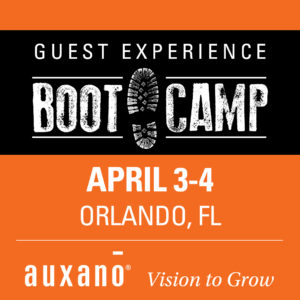
Don’t Put Your Guests First at Your Organization – Part 1
Editor’s Note: During our August focus on Guest Experiences, we are honored to have some of the best voices in the world of Customer Experience provide guest posts for the Vision Room. As you read the content below, simply think “Guest” where you see the word “customer” – and you will benefit from the knowledge and expertise of some great minds.
In this first part of a two-part series, I’ll outline some important ways to ensure that your company is putting the customer at the center of all it does.
Why are companies in business? For customers, right? To create and to nurture a customer, to be specific. And, yet, we still see some dismal statistics about how many companies don’t focus on the customer experience or think they focus on the customer experience but really don’t. In research published by Bain, they reported that:
- only 50% of management teams tailor their products and services to the needs of customers
- only 30% organize the functions of their company to deliver superior customer experiences
- only 30% maintain effective customer feedback loops
Temkin Group recently reported that 67% of large companies rate themselves as being good at soliciting customer feedback, but only 26% rate themselves as being good about making changes based on the insights.
These are dismal statistics. How do we turn this around?
If you haven’t yet started to focus on the needs of the customer, where should you begin? What can you do to turn the tide?
First you must decide. And then, when you’re ready to put the customer at the center of all you do, there are six important steps to take to get started:
1. Identify the customer
2. Understand the customer
3. Outline the customer lifecycle
4. Map the customer journey
5. Listen to your customers
6. Socialize the insights/findings
Step 1: Identify the Customer
Knowing who the customer is seems like a no-brainer, but you’d be surprised by how many companies have never gone through the exercise of identifying the customer. In a B2B organization, for example, customers can be many and varied; look within each customer or partner organization at the people you interact with, e.g., purchasing, product, support, accounting, end-users, etc. to identify your customer. The company is not the customer; the people you interact with within the company are. Not having a clear understanding of who the customer is hampers any further steps in this process.
Step 2: Understand the Customer
Once you’ve identified who your customers are, you must understand them and their needs. How do they interact with your organization? Why do they buy products and services from you? What are their needs? What problems are they trying to solve? What are they trying to achieve?
A tool to use to answer all of these questions is personas. Personas are fictional characters created to describe your ideal prospect or actual customer. They are derived through primary research – research that can then also be used for your customer journey maps in Step 4. They are specific to your business, not to the industry. The descriptions include vivid narratives, images, and other items that help companies understand the needs of the customer (contextual insights) and outline feelings, motivations, goals, behaviors, challenges, likes, dislikes, objections, and interests that drive buying (or other) decisions. Each persona includes a human face and name. Used properly, personas keep the customer alive and front and center for the entire organization. They tie in nicely to your journey maps and are necessary to begin that exercise.
A hardware client of mine developed supplier personas in order to better understand the different supplier personnel with which they interact. Different supplier types and different roles within a supplier company have different needs and interact differently with your organization; understanding those then allows you to create a better experience for all involved. For their personas, we looked at the different roles within supplier companies and came up with six primary personas: operations management, logistics, production schedulers, inventory management, shipping, and accounting. A lot of research went into defining these personas, which were then used to develop journey maps that laid out the experience they had when trying to achieve whatever it was each did with the client. These personas were then used to better manage supplier relationships and to design a better supplier experience with the client, one more personalized to each specific role/persona. The client saw a remarkable uptick in supplier satisfaction, and hence retention, as a result of this increased understanding.
Step 3: Outline the Customer Lifecycle
The lifecycle map shows the phases of the customer’s relationship with your company. It’s high level and good for understanding the overall relationship the customer has with the organization, from before he’s even considered a customer through when he is no longer a customer. It typically includes these stages: Need, Awareness, Consideration, Selection/Purchase, Experience, Loyalty, Advocacy, Engagement, Raving Fans. And, unfortunately, Exit. It’s not necessarily linear and often circles back on itself.
It’s great to understand the lifecycle at this high level before moving on to the next step. Lifecycle maps, while important to nurturing the overall customer relationship, are a natural first step to identifying listening needs along the lifecycle; however, to get to the heart of the matter, to really understand when and where to listen and to really design a better customer experience, you must dive deeper into the lifecycle stages, inventory the touchpoints, and map the customer journey, which I’ll discuss further in Step 4.
In my next post, I’ll wrap up the other three steps you can take to ensure that customers are front and center in your organization.
When a brand connects with their customer, that in some ways is the easy part, the hard part is keeping the customer at the center after the success/profits comes flooding in. Success can breed complacency, success can breed arrogance. -Anna Farmery

Want to learn how to create an EXCEPTIONAL Guest Experience at your church? Check out Auxano’s Guest Experience Boot Camp, coming to Orlando, FL on April 3-4.

Tags: Annette Franz, Church Guest Experiences, Guest Experiences












